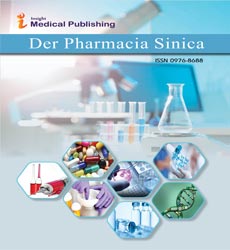ISSN : 0976 - 8688
Der Pharmacia Sinica
Formulation and Evaluation of Novel Herbal Nanoemulsions for Enhanced Drug Delivery
Anjun Malhotra*
Department of Pharmacognosy, National Institute of Pharmaceutical Education and Research, Mohali, India
*Corresponding author:
Anjun Malhotra,
Department of Pharmacognosy, National Institute of Pharmaceutical Education and Research, Mohali, India,
E-mail: anjunalhotra@esr.in
Received date: January 02, 2025, Manuscript No. ipdps-25-20775; Editor assigned date: January 04, 2025, PreQC No. ipdps-25-20775 (PQ ); Reviewed date: January 18, 2025, QC No. ipdps-25-20775; Revised date: January 24, 2025, Manuscript No. ipdps-25-20775 (R); Published date: January 31, 2025, DOI: 10.36648/2470-6973.16.01.02
Citation: Malhotra A (2025) Formulation and Evaluation of Novel Herbal Nanoemulsions for Enhanced Drug Delivery. Der Pharmacia Sinica Vol.16.No.01: 02
Introduction
Herbal medicines have been used for centuries due to their therapeutic potential, biocompatibility and minimal side effects. However, the clinical efficacy of many herbal bioactives is often limited by poor water solubility, low bioavailability and rapid metabolism. To overcome these challenges, recent research has focused on novel drug delivery systems, among which nanoemulsions have emerged as a promising platform. Nanoemulsions are submicron-sized colloidal dispersions composed of oil, water and surfactants that encapsulate hydrophobic drugs, enhancing solubility, stability and permeability. By integrating herbal bioactives into nanoemulsions, it is possible to improve pharmacokinetics, protect sensitive phytochemicals from degradation and enable targeted and controlled delivery, thereby maximizing therapeutic outcomes [1].
Description
The formulation of herbal nanoemulsions requires careful selection of components and optimization of preparation techniques. The choice of oil phase, surfactant and co-surfactant significantly influences droplet size, stability and drug-loading efficiency. Natural oils such as coconut oil, olive oil, or medium-chain triglycerides are commonly used due to their biocompatibility and ability to solubilize lipophilic herbal compounds. Surfactants, including nonionic agents like Tween 80 or Span 20, stabilize the nanoemulsion by reducing interfacial tension, while co-surfactants such as ethanol or propylene glycol enhance flexibility of the interfacial film. Preparation methods may include high-energy techniques like ultrasonication and high-pressure homogenization or low-energy methods like spontaneous emulsification. Optimizing process parameters-such as surfactant concentration, oil-to-water ratio and energy input-is essential to achieve nanoemulsions with uniform droplet size, high stability and maximum drug encapsulation. In vitro and in vivo evaluations are essential to assess the biological performance of herbal nanoemulsions. In vitro studies typically include drug release profiling, cell viability assays, antioxidant activity tests and permeability studies across intestinal or skin model [2].
Characterization of herbal nanoemulsions is critical to ensure quality, reproducibility and therapeutic efficacy. Key physicochemical parameters include droplet size and size distribution, zeta potential, viscosity, pH and drug content. Dynamic Light Scattering (DLS) is widely used to measure particle size, while zeta potential indicates colloidal stability and predicts long-term shelf-life. Morphological assessment using Transmission Electron Microscopy (TEM) or Scanning Electron Microscopy (SEM) provides insight into droplet shape and surface characteristics. In addition, encapsulation efficiency and drug-loading capacity are quantified to evaluate the nanoemulsionâ??s ability to carry the active herbal compound. Stability studies under various storage conditions assess potential phase separation, creaming, or Ostwald ripening, which can impact bioavailability. Comprehensive characterization ensures that the nanoemulsion is suitable for further in vitro and in vivo studies [3].
Herbal nanoemulsions offer significant advantages in enhancing drug delivery compared to conventional formulations. The nanoscale size of droplets increases surface area, improving dissolution rate and absorption through biological membranes. Furthermore, nanoemulsions can facilitate transdermal, oral, or nasal delivery, depending on the intended route of administration. Controlled-release properties can be engineered by modulating the composition or droplet structure, reducing dosing frequency and enhancing patient compliance. Studies have demonstrated that encapsulating herbal compounds like curcumin, quercetin and resveratrol in nanoemulsions significantly increases bioavailability, protects against enzymatic degradation and enhances therapeutic effects such as antioxidant, anti-inflammatory and anticancer activities. The ability to co-deliver multiple bioactives in a single nanoemulsion further expands the potential for synergistic therapeutic outcomes. Moreover, histopathological and biochemical analyses confirm safety and biocompatibility, establishing the translational potential of these formulations for human therapeutic applications [4,5].
Conclusion
The development of novel herbal nanoemulsions represents a promising strategy to overcome the limitations of conventional herbal drug delivery. Through careful selection of formulation components, optimization of preparation techniques and rigorous physicochemical and biological evaluation, nanoemulsions enhance solubility, stability, bioavailability and therapeutic efficacy of herbal compounds. This integrative approach bridges traditional herbal medicine with modern nanotechnology, offering potential solutions for a wide range of clinical applications, including chronic diseases, cancer therapy and anti-inflammatory treatments. As research advances, the combination of herbal bioactives with nanocarrier systems is poised to revolutionize natural product-based therapeutics, paving the way for safer, more effective and patient-friendly interventions.
Acknowledgement
None.
Conflict of Interest
None.
References
- Yu Z, Lv H, Han G, Ma K (2016). Ethosomes loaded with cryptotanshinone for acne treatment through topical gel formulation. PLoS One11: e0159967.
Google Scholar Cross Ref Indexed at
- Kumar P, Sharma DK, Ashawat MS (2022). Topical creams of piperine loaded lipid nanocarriers for management of atopic dermatitis: Development, characterization and in vivo investigation using BALB/c mice model. J Liposome Res32: 62-73.
Google Scholar Cross Ref Indexed at
- Thangapazham RL, Puri A, Tele S, Blumenthal R, Maheshwari RK (2008). Evaluation of a nanotechnology-based carrier for delivery of curcumin in prostate cancer cells. Int J Oncol32: 1119-1123.
Google Scholar Cross Ref Indexed at
- Li N Feng L, Tan Y, Xiang Y, Zhang R, Yang M (2018). Preparation, characterization, pharmacokinetics and biodistribution of baicalin-loaded liposome on cerebral ischemia-reperfusion after iv administration in rats. Molecules23: 1747.
Google Scholar Cross Ref Indexed at
- Zhang C, Gu C, Peng F, Liu W, Wan J, et al. (2013). Preparation and optimization of triptolide-loaded solid lipid nanoparticles for oral delivery with reduced gastric irritation. Molecules18: 13340-13356.
Open Access Journals
- Aquaculture & Veterinary Science
- Chemistry & Chemical Sciences
- Clinical Sciences
- Engineering
- General Science
- Genetics & Molecular Biology
- Health Care & Nursing
- Immunology & Microbiology
- Materials Science
- Mathematics & Physics
- Medical Sciences
- Neurology & Psychiatry
- Oncology & Cancer Science
- Pharmaceutical Sciences
